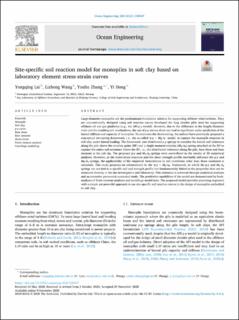| dc.description.abstract | Large-diameter monopiles are the predominant foundation solution for supporting offshore wind turbines. They are conventionally designed using soil reaction curves developed for long slender piles used for supporting offshore oil and gas platforms (e.g., the API p-y model). However, due to the difference in the length/diameter ratio and the resulting soil mechanisms, the use of p-y curves alone can lead to significant under-prediction of the lateral stiffness and capacity of monopiles. To overcome the shortcoming, the authors have previously proposed a conceptual two-spring framework, i.e., the so-called ‘p-y + MR-θR’ model, to capture the monopile response in soft clay under lateral loading. The framework uses distributed p-y springs to consider the lateral soil resistance along the pile above the rotation point (RP) and a single moment-rotation (MR-θR) spring attached at the RP to capture the entire soil resistance below the RP, i.e., the distributed resistance along the pile, base shear and base moment at the pile tip. The proposed p-y and MR-θR springs were curve-fitted to the results of 3D numerical analyses. However, as the stress-strain response and the shear strength profile inevitably influence the p-y and MR-θR springs, the applicability of the empirical formulations to soil conditions other than those examined is uncertain. This study proposes an enhancement to the ‘p-y + MR-θR’ framework, in which the p-y and MR-θR springs are not tied to a specific soil and strength profile but fundamentally linked to the properties that can be measured directly in the site investigation and laboratory. This extension is achieved through analytical analyses and an extensive parametric numerical study. The predictive capabilities of the model are demonstrated by backanalyses of finite element analyses and centrifuge model tests. The proposed model provides practising engineers with a simple yet powerful approach to use site-specific soil reaction curves in the design of monopiles embedded in soft clay. | |
